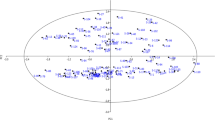Abstract
Pomegranate cultivation is one of the most attractive farming enterprises in the Indian arid tropics. However, the quality of the fruit is often severely affected by a physiological disorder called ‘aril browning’ in which a part or all the arils show discolouration (browning) and such fruits are unfit for consumption. This has become a serious concern to consumers, growers and researchers in the recent times. In order to understand the genotypic variation for aril browning and its association with other fruit traits, 158 progenies obtained by selfing two pomegranate multiple hybrids viz., {(‘Ganesh’ × ‘Kabul’) × ‘Yercaud’} × {(‘Ganesh’ × ‘Gulsha Rose Pink’)-F2} and {(‘Yercaud’ × ‘Jyothi’) × (‘Ganesh’ × ‘Gulsha Rose Pink’)-F2} × {(‘Ganesh’ × ‘Kabul’) × ‘Yercaud’} were studied. Because of heterozygous nature of the crop and diverse genetic base of parents, a wide array of recombinants were produced which were scored for aril browning, fruit skin colour, aril colour, total soluble solids (TSS) and seed mellowness. Results of Spearman’s correlation analysis revealed that aril browning is inversely related with aril colour (r = −0.41). A statistical model constructed to study the reasons for the observed variation in aril browning showed that about 82.9% of it was accounted collectively by skin colour, aril colour, TSS and seed mellowness. Further, a refined model represented by Y (aril browning severity) = 0.78 − 0.52 X1 (aril colour) + 0.23 X2 (TSS) was found to contribute to 73.5% of the observed variability in aril browning with least error in prediction. Analysis of data further showed that every unit increase in intensity of aril colour amounted to decrease in severity of aril browning by 0.52 units. However, for every unit increase in TSS there was an increase of 0.23 units in severity of aril browning. Thus, with the increase in intensity of aril colour there was a reduction in severity of aril browning while with raise in TSS, aril browning incidence was higher, an association often not favourable in selection of desirable genotypes. The results of the present study suggested that while developing varieties free from aril browning it is important to strike a balance between aril colour and TSS level.
Similar content being viewed by others
References
Delwiche SR, Mekwatanakarn W, Wang CY (2008) Soluble solids and simple sugars measurement in intact mango using near infrared spectroscopy. HortTechnology 18(3):325–544
Desai PVG (1989) Investigations on internal breakdown of pomegranate fruit. Ph.D. thesis, Mahatma Phule Agricultural University, Rahuri, India
Gross P (2009) Review of current research into pomegranates and antioxidant properties. http://chetday.com/pomegranateantioxidant.htm
Indian Horticulture Database (2006) National Horticulture Board (ed. Bijay Kumar). Ministry of Agriculture, Gurgaon, India
Introduction to Regression (2007) http://dss.princeton.edu/online_help/analysis/regression_intro.htm
Jalikop SH (2003) Rosetted siblings in F2 of a cross of pomegranate (Punica granatum L.) can be useful model for rosetting investigations. Euphytica 131:333–342
Jalikop SH, Kumar PS (1998) Use of semi-soft and hard-seeded types of pomegranate (Punica granatum L.) for improvement of fruit attributes. Indian J Agric Sci 68(2):87–91
Khodade MS (1987) Studies on physico-chemical changes during growth and development of pomegranate fruit (Punica granatum L.). M.Sc. (Agri.) thesis submitted to Mahatma Phule Agricultural University, Rahuri, India
Kulkarni AP, Aradhya SM (2005) Chemical changes and antioxidant activity in pomegranate arils during fruit development. Food Chem 93(2):319–324
Murata M, Haruta M, Murai N, Tanikava N, Nishimura M, Homa S, Itoh Y (2000) Transgenic apple (Malus × domestica) shoot showing low browning potential. J Agric Food Chem 48:5243–5248
Pawar SK, Desai OT, Choudhari SM (1994) Effect of pruning on physiological disorders in pomegranates. Ann Arid Zone 33:83–84
Richard FC, Gauillard FA (1997) Oxidation of chlorogenic acid, catechinsand 4-methylcatechol in model solutions by combinations of pear (Pyrus communis cv. Williams) polyphenol oxidase and peroxidase: a possible involvement of peroxidase in enzymatic browning. J Agric Food Chem 45:2472–2476
Ryan TP (1997) Modern regression methods. Wiley, New York
Sheikh MK (2006) The pomegranate. International Book, 192 p
Shete MB (1998) Effects of varieties, stage of harvest and bahar treatments on internal breakdown of pomegranate (Punica granatum L.) fruits. Ph.D. thesis submitted to Mahatma Phule Agricultural University, Rahuri, India
Shete B, Waskar DP (2005) Internal breakdown of pomegranate (Punica granatum L.) fruits—a review. J Maharashtra Agric Univ 30(1):59–61
Shivashankara KS, Subhas Chander M, Laxman RH, Vijayalaxmi GP, Bujjibabu CS (2004) Physiological and biochemical changes associated with aril browning of pomegranate (Punica granatum cv. Ganesh). J Plant Biol 31(2):149–152
Underhill SJR, Critchley C, Simons DH, Subhadrabandhu S (1992) Postharvest pericarp browning of lychee (Litchi chinensis Sonn.). Acta Hortic 321:718–725
Waskar DP, Kulkarni SR, Navale AM, Shete MB (2003) ‘Bhagwa’ and ‘Phule Arakta’. Mahatma Phule Krishi Vidyapeeth, Extention Bulletin No. 410
Acknowledgements
Thanks are due to Director, Indian Institute of Horticultural Research, Bangalore for providing facilities, Drs. R. Chithiraichelvan, S. Shivashankar and B.N.S. Murthy for manuscript editing and Mr. T.S. Vittala for technical support.
Author information
Authors and Affiliations
Corresponding author
Rights and permissions
About this article
Cite this article
Jalikop, S.H., Venugopalan, R. & Kumar, R. Association of fruit traits and aril browning in pomegranate (Punica granatum L.). Euphytica 174, 137–141 (2010). https://doi.org/10.1007/s10681-010-0158-3
Received:
Accepted:
Published:
Issue Date:
DOI: https://doi.org/10.1007/s10681-010-0158-3




